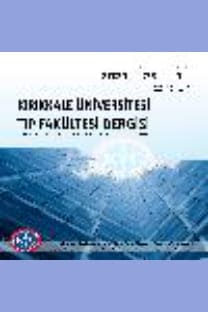Lamotrigin kullanan epileptik ratların yeni doğan yavrularının karaciğerlerinde oksidatif hasarın incelenmesi
Lamotrijin, epilepsi, gebelik, karaciğer, oksidatif stres
Pages 10-14
Lamotrigine, epilepsy, pregnancy, liver, oxidative stress,
___
- 1. Yerby MS. Pregnancy and epilepsy. Epilepsia. 1991; 32: 51-9.
- 2. Dansky LV, Andermann E, Andermann F. Marriage and fertility in epileptic patients. Epilepsia 1980; 21(3): 261-71.
- 3. Crawford P. Epilepsy and pregnancy.Seizure. 2002; 11: 212-9.
- 4. Katz JM, Pacia SV, Devinsky O. Current Management of Epilepsy and Pregnancy: Fetal Outcome, Congenital Malformations, and Developmental Delay.Epilepsy Behav. 2001; 2(2): 119-23.
- 5. Maertens P, Dyken P, Graf W, Pippenger C, Chronister R, Shah A. Free radicals, anticonvulsants and the neuronal ceroid lipofuscinoses.Am J Med Genet. 1995; 7: 225-8.
- 6. Martinez BC, Pita CE, Sanchez GY, Rodriguez LCM, Agil A. Lipid peroxidation in adult epileptic patients treated with valproic acid. Rev Neurol. 2004; 38: 101-6.
- 7. Stanton PK, Moskal JR. Diphenylhydantoin protects against hypoxia induced impairment of hippocampal synaptic transmission. Brain Res. 1991; 546: 351-4
- 8. Arora T, Mehta AK, Sharma KK, Mediratta PK. Effect of carbamazepine and lamotrigine on cognitive function and oxidative stress in brain during chemical epileptogenesis in rats. Basic Clin Pharmacol Toxicol. 2010; 106(5): 372-7.
- 9. Shor S, Koren G, Nulman I. Teratogenicity of lamotrigine. Can Fam Physician. 2007; 53(6): 1007-9.
- 10. Ornoy A.Neuroteratogens in man: an overview with special emphasis on the teratogenicity of antiepileptic drugs in pregnancy. Reprod Toxicol. 2006; 22(2): 214-26.
- 11. Bakare A, Shao L, Cui J, Young LT, Wang JF. Mood stabilizing drugs lamotrigine and olanzapine increase expression and activity of glutathione S-transferase in primary cultured rat cerebral cortical cells. Neurosci Lett. 2009; 455(1): 70-3.
- 12. Eren I, Naziroğlu M, Demirdaş A.Protective effects of lamotrigine, aripiprazole and escitalopram on depression-induced oxidative stress in rat brain. Neurochem Res. 2007; 32(7): 1188-95.
- 13. Agarwal NB, Agarwal NK, Mediratta PK, Sharma KK. Effect of lamotrigine, oxcarbazepine and topiramate on cognitive functions and oxidative stress in PTZ-kindled mice. Seizure. 2011; 20(3): 257-62
- 14. Fayad M, Choueiri R, Mikati M. Potential hepatotoxicity of lamotrigine. Pediatr Neurol. 2000; 22: 49-52.
- 15. Dubnov-Raz G, Shapiro R, Merlob P. Maternal lamotrigine treatment and elevated neonatal gamma-glutamyl transpeptidase. Pediatr Neurol 2006; 35: 220–222.
- 16. Paxinos G, Watson C. The rat brain in sterotaxic coordinates. San Diego, CA, Academic Press, 1982, Plate 25.
- 17. Mihara M, Uchiyama M. Determination of malonaldehyde precursor in tissues by thiobarbituric acid test. Anal Biochem. 1978; 86: 271–8.
- 18. Ellman GL. Tissue sulphhydryl groups. Arch Biochem Biophys. 1959; 82: 70–7. 19. Paglia DE, Valentine WN. Studies on the qualitative characterization of erythrocyte glutathione peroxidase. J Lab Clin Med. 1967; 70: 158–63.
- 20. Spielberg SP, Gordon GB, Blake DA, Mellits ED, Bross, DS. Anticonvulsant toxicity in vitro: possible role of arene oxides. Journal of Pharmacology and Experimental Therapeutics. 1981; 217: 386–89.
- 21. Hussaini, SH, Farrington EA. Idiosyncratic druginduced liver injury: an overview. Expert Opinion on Drug Safety. 2007; 6: 673–84.
- 22. Boelsterli UA, Lim PL. Mitochondrial abnormalities–a link to idiosyncraticdrug hepatotoxicity? Toxicology and Applied Pharmacology. 2007; 220: 92–107.
- 23. Neuman MG, Malkiewicz IM, Shear NH. A novel lymphocyte toxicity assay to assess drug hypersensitivity syndromes. Clinical Biochemistry. 2000; 33: 517–24.
- 24. Nitti M, Pronzato MA, Marinari UM, Domenicotti C. PKC signaling in oxidative hepatic damage. Molecular Aspects of Medicine. 2008; 29: 36–42.
- 25. Chang TKH, Abbott FS. Oxidative stress as a mechanism of valproic acid associated hepatotoxicity. Drug Metabolism Reviews. 2006; 38: 627–39.
- 26. Duncan JS, Thompson PJ. The cognitive consequences of epilepsy. Ann Neurol 2003; 54: 421–2.
- 27. Sudha K, Rao AV, Rao A. Oxidative stress and anti-oxidants in epilepsy. Clin Chim Acta. 2001; 303: 19–24.
- 28. Gupta YK, Kumar MHV, Srivastava AK. Effect of Centella asiatica on pentylenetetrazoleinduced kindling, cognition and oxidative stress in rats. Pharmacol Biochem Behav 2003; 74: 579- 85.
- 29. Aycicek A, Iscan A. The effects of carbamazepine, valproic acid and phenobarbital on the oxidative and antioxidative balance in epileptic children. European Neurology. 2007; 57: 65–9.
- 30. Santos NA, Medina WS, Martins NM, Rodrigues MA, Curti C, Santos AC. Involvement of oxidative stress in the hepatotoxicity induced by aromatic antiepileptic drugs.Toxicol In Vitro. 2008; 22(8): 1820-4.
- ISSN: 2148-9645
- Yayın Aralığı: Yılda 3 Sayı
- Başlangıç: 1999
- Yayıncı: KIRIKKALE ÜNİVERSİTESİ KÜTÜPHANE VE DOKÜMANTASYON BAŞKANLIĞI
İdiyopatik Hiperkalsiürik Çocukların Kemik Yoğunluğunun Değerlendirilmesi
, Meryem ÖNDER, Pınar İşık AĞRAŞ, F İnci ARIKAN, Ülper KURT, Yıldız DALLAR
Metaplastik Meme Karsinomu: Olgu Sunumu
Eda ELVERİCİ, , Ayşe Nurdan BARÇA, Mehtap ÇAVUŞOĞLU, Semra DURAN, Levent ARAZ
Premedikasyon için Uygulanan Midazolamdan Sonra Görülen Distoni: Olgu Sunumu
Yatak Yarasına Bağlı Gelişen Ülserde Epidural Analjezi Uygulamaları
Bir Meslek Lisesinde Öğle Yemeğine Ulaşmada Zorluk Yaşayan Öğrencilerin Beslenme Alışkanlıkları
Sevil ALBAYRAK, , Cemile ÇELEBİ, Ünzile TAŞKIN, Sinem ŞAŞMAZ, Selami ÇİÇEK
Retrobulber Blok Sonrası Olası Beyin Sapı Anestezisi Gelişen İki Olgu
Özden KAMIŞLI, , Handan SOYSAL, Zümrüt DOĞAN, Nihat EKİNCİ, Yusuf TÜRKÖZ
0-2 Yaş Grubu Bebeklerin Anne Sütü ile Beslenme Durumları ve Etkileyen Faktörler
